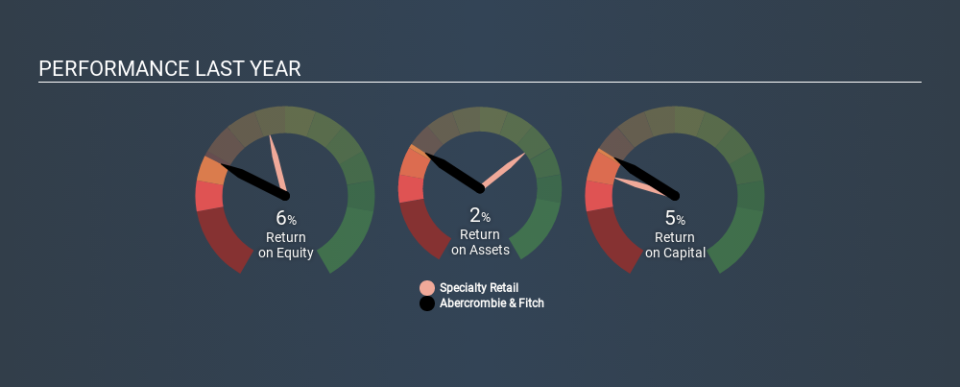Why Abercrombie & Fitch Co.’s (NYSE:ANF) Return On Capital Employed Might Be A Concern

Today we'll look at Abercrombie & Fitch Co. (NYSE:ANF) and reflect on its potential as an investment. Specifically, we're going to calculate its Return On Capital Employed (ROCE), in the hopes of getting some insight into the business.
First up, we'll look at what ROCE is and how we calculate it. Then we'll compare its ROCE to similar companies. Then we'll determine how its current liabilities are affecting its ROCE.
Return On Capital Employed (ROCE): What is it?
ROCE is a metric for evaluating how much pre-tax income (in percentage terms) a company earns on the capital invested in its business. All else being equal, a better business will have a higher ROCE. In brief, it is a useful tool, but it is not without drawbacks. Renowned investment researcher Michael Mauboussin has suggested that a high ROCE can indicate that 'one dollar invested in the company generates value of more than one dollar'.
How Do You Calculate Return On Capital Employed?
The formula for calculating the return on capital employed is:
Return on Capital Employed = Earnings Before Interest and Tax (EBIT) ÷ (Total Assets - Current Liabilities)
Or for Abercrombie & Fitch:
0.051 = US$134m ÷ (US$3.5b - US$837m) (Based on the trailing twelve months to November 2019.)
So, Abercrombie & Fitch has an ROCE of 5.1%.
View our latest analysis for Abercrombie & Fitch
Does Abercrombie & Fitch Have A Good ROCE?
ROCE can be useful when making comparisons, such as between similar companies. Using our data, Abercrombie & Fitch's ROCE appears to be significantly below the 11% average in the Specialty Retail industry. This performance could be negative if sustained, as it suggests the business may underperform its industry. Separate from how Abercrombie & Fitch stacks up against its industry, its ROCE in absolute terms is mediocre; relative to the returns on government bonds. It is possible that there are more rewarding investments out there.
We can see that, Abercrombie & Fitch currently has an ROCE of 5.1% compared to its ROCE 3 years ago, which was 3.2%. This makes us think the business might be improving. You can see in the image below how Abercrombie & Fitch's ROCE compares to its industry. Click to see more on past growth.
When considering this metric, keep in mind that it is backwards looking, and not necessarily predictive. Companies in cyclical industries can be difficult to understand using ROCE, as returns typically look high during boom times, and low during busts. This is because ROCE only looks at one year, instead of considering returns across a whole cycle. Since the future is so important for investors, you should check out our free report on analyst forecasts for Abercrombie & Fitch.
Do Abercrombie & Fitch's Current Liabilities Skew Its ROCE?
Short term (or current) liabilities, are things like supplier invoices, overdrafts, or tax bills that need to be paid within 12 months. Due to the way the ROCE equation works, having large bills due in the near term can make it look as though a company has less capital employed, and thus a higher ROCE than usual. To counter this, investors can check if a company has high current liabilities relative to total assets.
Abercrombie & Fitch has current liabilities of US$837m and total assets of US$3.5b. Therefore its current liabilities are equivalent to approximately 24% of its total assets. This is a modest level of current liabilities, which would only have a small effect on ROCE.
The Bottom Line On Abercrombie & Fitch's ROCE
With that in mind, we're not overly impressed with Abercrombie & Fitch's ROCE, so it may not be the most appealing prospect. Of course, you might also be able to find a better stock than Abercrombie & Fitch. So you may wish to see this free collection of other companies that have grown earnings strongly.
If you are like me, then you will not want to miss this free list of growing companies that insiders are buying.
If you spot an error that warrants correction, please contact the editor at editorial-team@simplywallst.com. This article by Simply Wall St is general in nature. It does not constitute a recommendation to buy or sell any stock, and does not take account of your objectives, or your financial situation. Simply Wall St has no position in the stocks mentioned.
We aim to bring you long-term focused research analysis driven by fundamental data. Note that our analysis may not factor in the latest price-sensitive company announcements or qualitative material. Thank you for reading.

